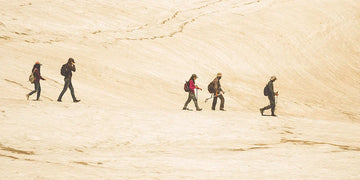Desert hiking offers incredible beauty, vast landscapes and unique wildlife. But it also presents unique and often unpredictable challenges. Unlike other climates, the desert's high temperatures, low humidity, strong winds, and drastic day-to-night temperature swings demand a thoughtful approach to your hiking attire. Without proper preparation, you risk dangers like dehydration, severe sunburn, and even hypothermia when temperatures plummet after sunset.
Perfect Desert-Friendly Hiking Fabrics
The fabrics you choose are crucial because they directly impact your body's ability to cool itself and withstand the harsh desert environment. High temperatures and low humidity can almost negate your body's natural cooling system, while rough terrain can quickly wear out soft materials, leaving you exposed.
Here is a breakdown of common hiking fabrics and their suitability for the desert.
Cotton: There's considerable debate about cotton in the outdoor community. Its hydrophilic nature means it absorbs moisture, making you feel sweaty during the day. However, in hot, dry desert climates, this moisture retention can be beneficial. Sweat evaporates so quickly in the desert that its cooling effect can be nullified; cotton holds moisture longer, allowing for proper evaporative cooling. The caveat is that you must be dry by nightfall, as cotton can sap body temperature quickly, leading to hypothermia as temperatures drop.
Polyester: Often advocated by hikers, polyester is excellent at wicking moisture. It also boasts other useful desert hiking characteristics: it's water-resistant for storms, insulating and quick-drying for chilly afternoons, and durable and abrasion-resistant for rough terrain. A downside is that polyester absorbs oil, not water, which can lead to body odors lingering.
Merino Wool: Known for being super comfortable, merino wool is said to have been used by Bedouin people to stay cool during hot days and warm during cold nights. Merino wool helps regulate body temperature, is odor-resistant, wicks and dries quickly, and is resilient. Lightweight merino wool is sweat-wicking and naturally anti-odor, though it can be less durable than synthetics.
Regardless of the fabric, loose-fitting clothing allows for better airflow, aiding in cooling.
Essential Clothing Items for Desert Hiking
When assembling your desert hiking outfit, prioritize lightweight layers and breathable fabrics with features like mesh panels and vents. Light colors are generally recommended as they reflect the sun's UV rays. Look for clothing with a UPF rating; the higher the UPF, the better the protection. A UPF 50+ rating means only 2% of UV radiation can penetrate the fabric.
Long-Sleeve Shirts / Sun Hoodies: These are paramount for protecting your skin from intense UV rays, bugs, and thorny shrubs. Many hikers, especially those thru-hiking, prefer long-sleeved sun shirts or hoodies. Look for lightweight, breathable, moisture-wicking materials. A hood provides additional sun protection for your neck and ears, and thumbholes help keep sleeves in place and protect the backs of your hands.
Long Pants: Essential for protection from the sun, thorns, scratches, and bugs. Choose loose-fitting pants to allow airflow and aid cooling. Convertible pants are highly versatile, allowing you to zip off the lower half to wear them as shorts during the day and reattach for cooler evenings.
Jacket / Outer Layer: Even in the desert, temperatures can drop dramatically at night. A lightweight jacket is crucial for warding off hypothermia if you get stuck overnight. Look for something breathable, light, and wind/water-resistant.
Underwear and Socks: Unlike outer layers, avoid cotton underwear as it holds moisture, increasing chafing and potential fungal infections. Opt for moisture-wicking synthetics like nylon boxer briefs. For socks, non-cotton, moisture-wicking socks are essential to keep your feet dry and prevent blisters.
Essential Accessories for Desert Sun Protection

Beyond clothing, several accessories are vital for comprehensive sun protection:
Wide-Brimmed Hat: A must-have, providing superior sun protection for your face, ears, and neck. Look for lightweight, breathable materials with UPF protection. A chin strap is important to prevent it from blowing away in the wind.
Sunglasses: The desert sun can be incredibly harsh. High-quality, UV-protective sunglasses are essential. Wrap-around styles offer the best protection for the front and sides of your eyes.
Neck Gaiter or Bandana: Sun Proof Neck drapes and bandanas can provide added protection for your neck, or be soaked in water and draped around your neck for cooling.
Gloves / Mittens: Your hands are highly exposed to UV rays. UV mittens or gloves are an excellent way to shield them. If wearing a short-sleeve sun tee, UV arm cuffs can protect your arms and forearms.
Cooling Gear: Consider packing cooling towels or bandanas that can be wet and placed around your neck or head for a quick refresh.
UV Umbrella (Optional): An umbrella designed for UV protection can provide portable shade wherever you stop, even in exposed areas.
Crucial Beyond Clothing: Hydration and Footwear
While not clothing, these elements are inextricably linked to your safety and comfort in the desert:
Hydration: This is arguably the most important thing you can carry in the desert. You need at least one gallon of water per person per day, and you should drink before you get thirsty. Electrolytes are essential in hot conditions, as they replenish salts lost through sweat.
Footwear: The desert's rocky, uneven terrain and thorns are hard on your feet. Investing in good quality, sturdy hiking boots is paramount. High tops offer ankle support and protection from thorns. Avoid black boots, as they can cause your feet to bake.
Final Thoughts for Your Desert Journey
Desert hiking is far more unpredictable than many realize, but with the right clothing and gear, you can transform a potentially hazardous trip into an enriching experience. Remember to always be prepared for wide temperature swings, strong sun, and rugged terrain. By choosing lightweight, breathable, and UPF-rated layers, protecting your skin from head to toe, and prioritizing hydration, you will be well-equipped to face the desert's challenges and fully enjoy its incredible beauty.
Gear up with CoolNES and feel the confidence that outshines the sun.





